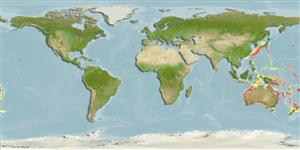Environment: milieu / climate zone / depth range / distribution range
Ekologi
marina bottenlevande. Temperate
Western Pacific. Likely to occur in the South China Sea (Ref. 41603).
Size / Vikt / Age
Maturity: Lm ? range ? - ? cm
Max length : 30.0 cm SL hane/ej könsbestämd; (Ref. 559)
Occurs over soft bottom (Ref. 75154) of the continental slope (Ref. 7300, 75154). Benthic (Ref. 75154).
Life cycle and mating behavior
Könsmognad | Reproduktion | Lek | Ägg | Fecundity | Larver
Paxton, J.R., D.F. Hoese, G.R. Allen and J.E. Hanley, 1989. Pisces. Petromyzontidae to Carangidae. Zoological Catalogue of Australia, Vol. 7. Australian Government Publishing Service, Canberra, 665 p. (Ref. 7300)
IUCN Red List Status (Ref. 130435: Version 2024-1)
Threat to humans
Harmless
Human uses
Verktyg
Special reports
Download XML
Internet-källor
Estimates based on models
Preferred temperature (Ref.
123201): 10.4 - 19.8, mean 14.4 °C (based on 197 cells).
Phylogenetic diversity index (Ref.
82804): PD
50 = 0.5002 [Uniqueness, from 0.5 = low to 2.0 = high].
Bayesian length-weight: a=0.01000 (0.00244 - 0.04107), b=3.04 (2.81 - 3.27), in cm total length, based on all LWR estimates for this body shape (Ref.
93245).
Trofisk nivå (Ref.
69278): 3.8 ±0.4 se; based on size and trophs of closest relatives
Fishing Vulnerability (Ref.
59153): Low to moderate vulnerability (27 of 100).
